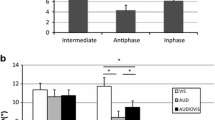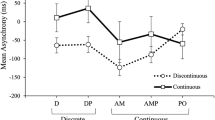Abstract
Rhythmic movements produced by humans become spontaneously entrained to auditory rhythms in the environment. Evidence suggests that synchronisation to external auditory rhythms can contribute to the stabilisation of movements in time and space, opening new perspectives for motor training and rehabilitation. Here we compared the effects of single (1:1) and double (1:2) metronomes (i.e., one or two stimulations per preferred movement cycle) on spontaneous movement entrainment and stabilisation. We examined the spontaneous entrainment of self-paced hand-held pendulum swinging when single or double metronomes were presented either at the participant’s preferred tempo or slightly slower or faster (± 10%). The results showed that participants’ movements spontaneously entrained to auditory rhythms, and that the strength of this entrainment was the same for single and double metronomes. However, double metronomes decreased movement tempo stability, whereas single metronomes increased movement tempo stability compared to a control condition without a stimulus. These effects preferentially occurred for metronomes presented at participants’ preferred movement tempi and especially for participants whose movements were intrinsically more variable. Participants’ movement amplitude stability was also modulated in such a way that the stability of participants who were intrinsically less stable increased, whereas the stability of intrinsically more stable participants decreased with auditory rhythms, an effect that was stronger with double than single metronomes. Moreover, movement stabilisation in time and space were positively correlated, suggesting that tempo and amplitude stabilisation depend on similar processes and may be complementary. These findings provide new insight into the processes underlying auditory-motor entrainment and how auditory rhythms can be used to improve movement stability in time and space.





Similar content being viewed by others

References
Assisi CG, Jirsa VK, Kelso JS (2005) Dynamics of multifrequency coordination using parametric driving: theory and experiment. Biol Cybern 93:6–21
Bardy BG, Hoffmann CP, Moens B, Leman M, Dalla Bella S (2015) Sound-induced stabilization of breathing and moving. Ann N Y Acad Sci 1337:94–100
Batschelet E (1981) Circular statistics in biology, vol 371. Academic Press, London
Beek PJ (1989) Juggling dynamics. Free University Press, Oxford
Beek PJ, Schmidt RC, Morris AW, Sim MY, Turvey MT (1995) Linear and nonlinear stiffness and friction in biological rhythmic movements. Biol Cybern 73:499–507
Bood RJ, Nijssen M, Van Der Kamp J, Roerdink M (2013) The power of auditory-motor synchronization in sports: enhancing running performance by coupling cadence with the right beats. PloS One 8:e70758
Burger B, Thompson MR, Luck G, Saarikallio SH, Toiviainen P (2014) Hunting for the beat in the body: on period and phase locking in music-induced movement. Front Hum Neurosci 8:903
Byblow WD, Carson RG, Goodman D (1994) Expressions of asymmetries and anchoring in bimanual coordination. Hum Mov Sci 13:3–28
Coey CA, Varlet M, Schmidt RC, Richardson MJ (2011) Effects of movement stability and congruency on the emergence of spontaneous interpersonal coordination. Exp Brain Res 211:483–493
Coey CA, Varlet M, Richardson MJ (2012) Coordination dynamics in a socially situated nervous system. Front Hum Neurosci 6:164
Demos AP, Chaffin R, Begosh KT, Daniels JR, Marsh KL (2012) Rocking to the beat: Effects of music and partner’s movements on spontaneous interpersonal coordination. J Exp Psychol Gen 141:49–53
Dotov DG, Bayard S, de Cock VC, Geny C, Driss V, Garrigue G, Bardy B, Dalla Bella S (2017) Biologically-variable rhythmic auditory cues are superior to isochronous cues in fostering natural gait variability in Parkinson’s disease. Gait Posture 51:64–69
Fink PW, Foo P, Jirsa VK, Kelso JA (2000) Local and global stabilization of coordination by sensory information. Exp Brain Res 134:9–20
Fuchs A, Jirsa VK, Haken H, Kelso JS (1996) Extending the HKB model of coordinated movement to oscillators with different eigenfrequencies. Biol Cybern 74:21–30
Ghai S, Ghai I, Schmitz G, Effenberg AO (2018) Effect of rhythmic auditory cueing on Parkinsonian gait: a systematic review and meta-analysis. Sci Rep 8:506
Haken H, Kelso JS, Bunz H (1985) A theoretical model of phase transitions in human hand movements. Biol Cybern 51:347–356
Hove MJ, Keller PE (2015) Impaired movement timing in neurological disorders: rehabilitation and treatment strategies. Ann N Y Acad Sci 1337:111–117
Jirsa VK, Fink PW, Foo P, Kelso JAS (2000) Parametric stabilization of biological coordination: a theoretical model. J Biol Phys 26:85–112
Kay BA, Kelso JA, Saltzman EL, Schöner G (1987) Space–time behavior of single and bimanual rhythmical movements: data and limit cycle model. J Exp Psychol Hum Percept Perform 13:178–192
Kelso JS (1997) Dynamic patterns: the self-organization of brain and behavior. MIT Press, Cambridge
Kudo K, Park H, Kay BA, Turvey MT (2006) Environmental coupling modulates the attractors of rhythmic coordination. J Exp Psychol Hum Percept Perform 32:599–609
Kugler PN, Turvey MT (1987) Information, natural law, and the self-assembly of rhythmic movement. Routledge, Abingdon
Large EW (2008) Resonating to musical rhythm: theory and experiment. In: Grondin S (ed) The psychology of time. Emerald, Cambridge, pp 189–231
Leman M, Moelants D, Varewyck M, Styns F, van Noorden L, Martens JP (2013) Activating and relaxing music entrains the speed of beat synchronized walking. PloS One 8:e67932
Lopresti-Goodman SM, Richardson MJ, Silva PL, Schmidt RC (2008) Period basin of entrainment for unintentional visual coordination. J Mot Behav 40:3–10
MacRitchie J, Varlet M, Keller PE (2017) Embodied expression through entrainment and co-representation in musical ensemble performance. Companion of embodied music. Routledge, New York
McIntosh GC, Brown SH, Rice RR, Thaut MH (1997) Rhythmic auditory-motor facilitation of gait patterns in patients with Parkinson’s disease. J Neurol Neurosurg Psychiatry 62:22–26
Miyata K, Varlet M, Miura A, Kudo K, Keller PE (2017) Modulation of individual auditory-motor coordination dynamics through interpersonal visual coupling. Sci Rep 7:16220
Miyata K, Varlet M, Miura A, Kudo K, Keller PE (2018) Interpersonal visual interaction induces local and global stabilisation of rhythmic coordination. Neurosci Lett 682:132–136
Néda Z, Ravasz E, Brechet Y, Vicsek T, Barabási AL (2000) Self-organizing processes: the sound of many hands clapping. Nature 403:849–850
Phillips-Silver J, Aktipis CA, Bryant GA (2010) The ecology of entrainment: foundations of coordinated rhythmic movement. Music Percept 28:3–14
Pikovsky A, Rosenblum M, Kurths J, Kurths J (2003) Synchronization: a universal concept in nonlinear sciences, vol 12. Cambridge University Press, Cambridge
Repp BH (2003) Rate limits in sensorimotor synchronization with auditory and visual sequences: the synchronization threshold and the benefits and costs of interval subdivision. J Mot Behav 35:355–370
Repp BH (2006) Does an auditory distractor sequence affect self-paced tapping? Acta Psychol 121:81–107
Repp BH, Su YH (2013) Sensorimotor synchronization: a review of recent research (2006–2012). Psychol Bull Rev 20:403–452
Richardson MJ, Marsh KL, Isenhower RW, Goodman JR, Schmidt RC (2007) Rocking together: dynamics of intentional and unintentional interpersonal coordination. Hum Mov Sci 26:867–891
Roerdink M, Lamoth CJ, van Kordelaar J, Elich P, Konijnenbelt M, Kwakkel G, Beek PJ (2009) Rhythm perturbations in acoustically paced treadmill walking after stroke. Neurorehabilit Neural Repair 23:668–678
Roerdink M, Bank PJ, Peper CLE, Beek PJ (2011) Walking to the beat of different drums: practical implications for the use of acoustic rhythms in gait rehabilitation. Gait Posture 33:690–694
Roerdink M, Ridderikhoff A, Peper CE, Beek PJ (2013) Informational and neuromuscular contributions to anchoring in rhythmic wrist cycling. Ann Biomed Eng 41:1726–1739
Schmidt RC, O’Brien B (1997) Evaluating the dynamics of unintended interpersonal coordination. Ecol Psychol 9:189–206
Schmidt RC, Richardson MJ (2008) Dynamics of interpersonal coordination. In: Fuchs A, Jirsa VK (eds) Coordination: neural, behavioral and social dynamics. Springer, Heidelberg, pp 281–308
Sihvonen AJ, Särkämö T, Leo V, Tervaniemi M, Altenmüller E, Soinila S (2017) Music-based interventions in neurological rehabilitation. Lancet Neurol 16:648–660
Styns F, van Noorden L, Moelants D, Leman M (2007) Walking on music. Hum Mov Sci 26:769–785
Thaut MH, McIntosh GC, Rice RR, Miller RA, Rathbun J, Brault JM (1996) Rhythmic auditory stimulation in gait training for Parkinson’s disease patients. Mov Disord 11:193–200
Thaut MH, McIntosh GC, Rice RR (1997) Rhythmic facilitation of gait training in hemiparetic stroke rehabilitation. J Neurol Sci 151:207–212
Tognoli E, Lagarde J, DeGuzman GC, Kelso JS (2007) The phi complex as a neuromarker of human social coordination. Proc Natl Acad Sci USA 104:8190–8195
Torre K, Varlet M, Marmelat V (2013) Predicting the biological variability of environmental rhythms: weak or strong anticipation for sensorimotor synchronization? Brain Cogn 83:342–350
van Ulzen NR, Lamoth CJ, Daffertshofer A, Semin GR, Beek PJ (2008) Characteristics of instructed and uninstructed interpersonal coordination while walking side-by-side. Neurosci Lett 432:88–93
Van Dyck E, Moens B, Buhmann J, Demey M, Coorevits E, Dalla Bella S, Leman M (2015) Spontaneous entrainment of running cadence to music tempo. Sports Med Open 1:15
Varlet M, Marin L, Lagarde J, Bardy BG (2011) Social postural coordination. J Exp Psychol Hum Percept Perform 37:473–483
Varlet M, Stoffregen TA, Chen FC, Alcantara C, Marin L, Bardy BG (2014) Just the sight of you: postural effects of interpersonal visual contact at sea. J Exp Psychol Hum Percept Perform 40:2310–2318
Varlet M, Bucci C, Richardson MJ, Schmidt RC (2015) Informational constraints on spontaneous visuomotor entrainment. Hum Mov Sci 41:265–281
Varlet M, Schmidt RC, Richardson MJ (2016) Influence of internal and external noise on spontaneous visuomotor synchronization. J Mot Behav 48:122–131
Varlet M, Novembre G, Keller PE (2017a) Dynamical entrainment of corticospinal excitability during rhythmic movement observation: a transcranial magnetic stimulation study. Eur J Neurosci 45:1465–1472
Varlet M, Wade A, Novembre G, Keller PE (2017b) Investigation of the effects of transcranial alternating current stimulation (tACS) on self-paced rhythmic movements. Neuroscience 350:75–84
von Holst E (1973) Relative coordination as a phenomenon and as a method of analysis of central nervous system function. In: Martin R (ed) The collected papers of Erich von Holst: vol 1. The behavioral physiology of animal and man. University of Miami Press, Coral Gables, pp 33–135 (Original work published 1939)
Walton AE, Richardson MJ, Langland-Hassan P, Chemero A (2015) Improvisation and the self-organization of multiple musical bodies. Front Psychol 6:313
Zamm A, Pfordresher PQ, Palmer C (2015) Temporal coordination in joint music performance: effects of endogenous rhythms and auditory feedback. Exp Brain Res 233:607–615
Zamm A, Wellman C, Palmer C (2016) Endogenous rhythms influence interpersonal synchrony. J Exp Psychol Hum Percept Perform 42:611–616
Acknowledgements
This work was supported by an Australian Research Council Discovery project (DP170104322) and an Australian Research Council Future Fellowship grant awarded to P.K. (FT140101162).
Author information
Authors and Affiliations
Corresponding author
Ethics declarations
Conflict of interest
The authors declare no conflict of interest.
Rights and permissions
About this article
Cite this article
Varlet, M., Williams, R., Bouvet, C. et al. Single (1:1) vs. double (1:2) metronomes for the spontaneous entrainment and stabilisation of human rhythmic movements. Exp Brain Res 236, 3341–3350 (2018). https://doi.org/10.1007/s00221-018-5382-4
Received:
Accepted:
Published:
Issue Date:
DOI: https://doi.org/10.1007/s00221-018-5382-4



